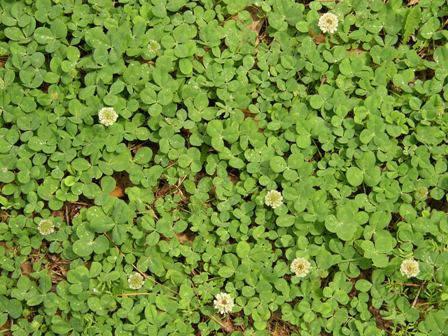by Keith Baldwin, Farm Services Coordinator

Ladino Clover. Photo credit: Wayne County Cooperative Extension
Overseeding of pasture or hay land with cool season annual legumes and grasses and with perennial legumes can be made much later in sod than in prepared seedbeds because the existing sod provides protection for the developing seedlings during the winter. In fact, planting should be delayed until about October 15th in the Coastal Plain and Piedmont. In the Mountains, the fall overseeding window of opportunity is closed, but February to March plantings provide an upcoming alternative.
In many fescue pastures and hay fields, the condition and quality of the forage could be greatly improved if the legume component in the field could be increased to more than 40% of the species present. At 40% of the mix, ladino clover (if adapted to the site) overseeded into a grass pasture would reduce the need for supplemental nitrogen (N) fertilizer from 150 lbs N/acre to 50 lbs N/acre. Intensive grazing on that same pasture would remove any need for supplemental N. Research has shown that a ladino clover/fescue mix with no supplemental N fertilizer provides an equivalent yield of dry matter as the fescue alone with 150 lbs/acre of N fertilizer.
For high, daily animal performance, it is particularly important to include a legume in the forage mix when endophyte-infected fescue is the base forage. Animal performance on average will be increased by about 0.5 pounds per day.
Fescue pastures can be overseeded now with perennial legumes such as ladino or red clover. The best method of seeding is with a no-till drill. Many NC Soil and Water Conservation Districts have no-till drills that can be “rented.” The going rate is $10 per acre. Seeding rate for drilling is 3 to 5 lbs/acre for ladino and 8 to 10 lbs/acre for red clover. Broadcast rates for the two clovers are 5 and 10 to 15 lbs/acre, respectively.
Bermudagrass pasture and hay fields can likewise be overseeded now with perennial legumes. However, more commonly, they are overseeded with either an annual cool-season grass such as ryegrass or rye or with an annual cool-season legume such as crimson clover, arrowleaf clover, winter pea or vetch. Annual ryegrass and crimson clover may be the best choices for overseeding, as they easiest to manage proven performers year in/year out .
A winter annual legume can lengthen the spring grazing season by four to eight weeks and also add a considerable amount of N to the grass. Legumes can add 90 to 120 lbs N per acre to the pasture system and yield three to four thousand lbs of dry mater per acre at peak growth. Legumes also can capture 12 to 14 lbs of P per acre, making them a tool for maintaining proper soil mineral balance. In addition to providing high-quality forage, the legumes boost crude protein and TDN contents in the hay harvested from pasture, particularly in the early cuttings.
Use 15 to 20 lbs of a reseeding variety of clover such as crimson or arrowleaf, or use 25 to 30 lbs per acre of hairy vetch or winter peas. Annual ryegrass is drilled at 20 to 30 lbs/acre. For more information on seeding, see: http://efotg.sc.egov.usda.gov/references/public/NC/forageplantguideNC.pdf.
When overseeding bermudagrass hay fields in the fall with winter annuals, clip the bermudagrass to stubble height of 3 inches or less. For pastures, establish a grazing height of 1 to 2 inches before overseeding because bermudagrass pasture sod is thicker than hay field sod. Graze bermudagrass close during late September and October to prevent shading of overseeded ryegrass during the establishment phase. Sod seed into bermudagrass with no preparation or disk first with blades perpendicular to soil surface. Do not overseed bermudagrass in the establishment year.
Timely removal of a winter annual that is overseeded in bermudagrass is essential for its survival. An overseeded crop left on the bermudagrass too long shades the bermudagrass when it is trying to re-emerge from winter dormancy. An overseeded winter annual grass should be harvested at the “boot” state of growth, prior to emergence of seed heads from the sheath. This would typically be late March to early April.
Spring and fall are critical periods for allowing crimson clover to re-establish from natural reseeding. In the spring, crimson clover seed must be allowed to mature, which will cause severe shading and delay spring growth of the bermudagrass; therefore, do not overseed all the bermudagrass acres. In the fall, maintain the bermudagrass at a height of two inches to allow the clover seed to germinate and develop. A light disking is often helpful.
A “Forage Facts Grazing Guide” provides details on the length of time to wait between establishment of overseeded species and grazing. That document is available at: http://www.cefs.ncsu.edu/whatwedo/researchunits/amazing-grazing-forage-facts-guide-sept-2012.pdf.
Did you know that the Natural Resources Conservation Service (NRCS) EQIP Organic Initiative will provide financial assistance to transitioning and certified producers for preparing and seeding/overseeding pastures and hay fields? Contact your local NRCS District Conservationist. Or contact Keith at CFSA at keith@.


